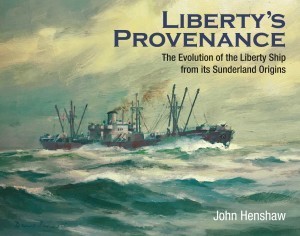
Liberty’s Provenance; The Evolution of the Liberty Ship from its Sunderland Origins. By John Henshaw. Seaforth Publishing, Barnsley 2019.
Reviewed by Tim Coyle
The Liberty ship, together with the C-47 aircraft and the Jeep are considered by some to have contributed to victory in World War 2. This is undoubtedly a subjective opinion; however, there is no doubt that these designs were innovative, flexible and suitable for mass production as only the United States’ prodigious production capability could accomplish between 1942 and 1945. Two thousand, seven hundred and ten Liberty ships were produced between April 1941 and 10 July 1944 when production was switched to an improved ‘Victory’ ship. Generally regarded as a triumph of American design and production this book sets out to set the record straight.
Liberty’s Provence author, John Henshaw, convincingly argues his case that the Liberty ship was far from being ‘all-American’ but was in fact a derivative of a British design conceived in the obscure North Sands, Sunderland shipyard of Joseph Thompson and Sons Limited. The surplus of World War One merchant ships – built in British and American yards to replace those lost by U-boat attack – caused a slump in post war construction which lasted well into the 1930s. The Thompson yard used the depressed market to develop a cheaper, better performing 10 000-ton cargo ship. Young Robert Cyril Thompson used National Physical Laboratory testing tanks to model varying hull forms. A hull featuring a fuller entry, a raked bow and finer lines leading to a stern post with a cruiser stern and semi-balanced rudder was matched with an improved vertical triple expansion engine. Although not new concepts, Thompson put these features together in the SS Embassade, launched in July 1935. Embassade proved successful in service and a slightly longer and wider SS Dorington Court was completed in May 1939.
In September 1940 Thompson, then 33 years old and highly regarded in the industry for his competence and, in the Admiralty’s opinion the best practical merchant ship design as demonstrated in Embassade and Dorington Court, was asked by the Controller of Merchant Shipbuilding and Repairs to lead a Merchant Shipbuilding Mission to the US, His task was ‘…to endeavour to obtain at the earliest possible moment the delivery of Merchant tonnage from USA shipyards at the rate per annum of about 60 vessels of the Tramp type each averaging about 10 000 tons deadweight and of 10.5 knots service speed, loaded, in fair weather and to make provision for the building of 30 such vessels’.
Twenty days after the Mission’s arrival in the US it met the formidable industrialist Henry J Kaiser. The British accepted that new yards would have to be established for their ships and Kaiser was best placed to oversee the project. The British had to accept that the cost of the shipyards would have to be amortised over the 60 ships. Admiral Emory S Land, head of the US Maritime Commission and focussed on US shipping requirements, saw value in getting the British to pay for the new yards which then would be turned over to US production. Contracts were signed on 01 December 1940 with Kaiser for two yards, one In Richmond, California, and the other in Portland, Maine. Thompson then left for Britain; enroute his ship was torpedoed off the Orkneys and he spent nine hours in freezing conditions in a lifeboat before rescue. He had the forethought to take his briefcase with him containing the contracts when he abandoned ship. On arrival back at the Admiralty the sodden contracts were retyped for the Chancellor of the Exchequer’s signature.
Henshaw’s argues the gestation of the Liberty ship was: Embassade and Dorington Court leading to derivatives built by Thompson’s: Empire Wind class (10 ships completed October 1940-October 1941) and Empire Liberty class (13 ships completed November 1941 to September 1944). According to Henshaw, Empire Liberty as the model for the Kaiser-built Ocean class (completed November 1941 to October 1944). Two further offshoots were the ‘Fort’, ‘Park’ and ‘Victory’ ships built in Canadian yards (January 1942 to March 1946) and finally the definitive ‘Liberty’ ship.
The book’s first seven chapters are cover the Battle of the Atlantic in World War One, British and US emergency ships designs, the US Shipping Board and Emergency Fleet Corporation, the shipping situation between the wars and the second Battle of the Atlantic of World War Two. As such this book provides an excellent overview of wartime emergency shipping which leads to the main topic of Thompson’s designs and the Liberty ship saga.
As with many historical records, revisionism and inaccuracies, intentional or not, come to be accepted as fact, particularly as time elapses. So it appears to be with the Liberty ship and Henshaw’s book is dedicated to ensuring that Thompson’s yard is credited for the genesis of Liberty, contrary to claims made by US interests. The book is meticulously researched with a many illustrations, not least of which are ship drawings largely executed by Henshaw himself.
The Liberty ship served for many years after the war until sold out of commercial service, but many remained in in the RN and the US services. The fine-lined, commodious hulls found uses in many converted guises.
The hero of the story is Robert Thompson. After accomplishing his mission to the US, and surviving a sinking, he sought to join the Royal Navy. However, the Admiralty decided his work was too important; he promptly joined the Royal Air Force as an aircraftsman second class and flew as a flight sergeant flight engineer in Liberator bombers. Awarded Commander of the British Empire in 1941 for his shipping work, the ribbon of the award on his RAF uniform must have raised some comment!
This is a book for ship enthusiasts and those who enjoy reading finely argued technicalities. While over 70 years have passed since these events the record of the Liberties has been definitively corrected. Liberty’s Provenance does this exceptionally well.



